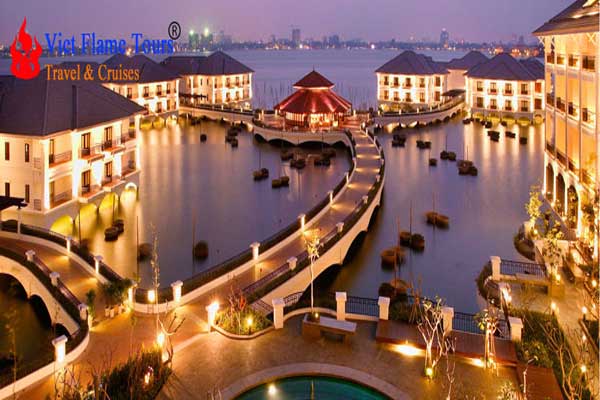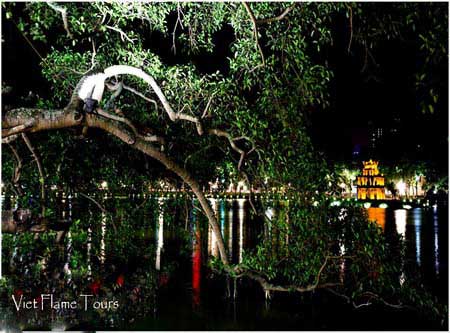HANOI OLD QUARTER- HANOI CAPITAL OF VIETNAM

HOAN KIEM LAKE
A green and peaceful Hanoi, a fast-growing hospitable city with great tourism potentials, is now open and warmly welcome friends from all over the world. The below list of attractions are the must-see sightseeing when you are visiting Hanoi.
- Hanoi Opera House
The beautiful Hanoi Opera House was built in 1911 by the then ruling French. It’s a phenomenal piece of neo-classical French architecture featuring Gothic themes on the doors and domes with pillars, shuttered windows, balconies and a glass room. Musicians, actors and dancers play to a 600-strong audience delivering powerful operatic and classical performances, making it a very popular theatrical attraction. The Hanoi Opera House is the biggest theatre in Vietnam and speaks volumes as historical and cultural evidence of Vietnam under French rule. The interior is even more magnificent than the exterior with many arguing it is aesthetically even more appealing than the Paris Opera House. Visitors today will be entertained at this architectural landmark which features a range of events including local Vietnamese opera, traditional folk music, ballets and many international concerts. - Hoan Kiem lake (300metres away from the hotel) is the liquid heart of the Old Quarter, a good orienting landmark. Legend has it that in the mid – 15th century, heaven gave Emperor Ly Thai To a magical sword that he used to drive the Chinese out of Vietnam. One day after the war, while out boating, he came upon a giant golden tortoise; the creature grabbed the sword and disappeared into the depths of the lake. Since that time, the lake has been known as Ho Hoan Kiem (Lake of the Restored Sword) because the tortoise returned the sword to its divine owners.
- Ngoc Son Temple: This Hanoi’s most visited temple sits pretty on a delightful little island in the northern part of Hoan Kiem Lake. An elegant scarlet bridge, The Huc Bridge, constructed in classical Vietnamese style and lined with flags, connects the island to the lake shore. The nearby Martyrs’ Monument was erected as a memorial to those who died fighting for Vietnam’s independence.
Surrounded by water and shaded by trees, the small temple is dedicated to General Tran Hung Dao (who defeated the Mongols in the 13th century), La To (patron saint of physicians) and the scholar Van Xuong. Inside you’ll find some fine ceramics, a gong or two, some ancient bells and a glass case containing a stuffed lake turtle, which is said to have weighed a hefty 250kg. - Memorial House: One of the Old Quarter’s best-restored properties, this traditional merchants’ house is sparsely but beautifully decorated, with rooms set around two courtyards and filled with fine furniture. Note the high steps between rooms, a traditional design incorporated to stop the flow of bad energy around the property.
There are crafts and trinkets for sale here, including silver jewellery, basketwork and Vietnamese tea sets, and there’s usually a calligrapher or other craftsperson at work too. - Bach Ma Temple (White Horse Temple): The Bach Ma temple at 76 Hang Buom Street honors a white horse which was thought to be an incarnation of a local river god. In the spring of the year 1010, the founder of the Ly dynasty, Ly Thai To issued the “Edict of the Transfer of the Capital”, which declared the transfer of the capital from Hoa Lu to Dai La (today’s Hanoi). After Ly settled in Hanoi, his laborers worked for a year and a half to construct a mighty citadel, but each time they erected the walls the marshy soil would give way. One day, while the king was praying, an apparition of a white horse appeared before the king and marked off an area using its hoof prints. The king understood that the horse was indicating a safe area to construct the citadel, and indeed, the fortress erected at the site remained standing. In gratitude, the king established Bach Ma temple in 1010 to honor the White Horse who assisted the fledgling city. The temple has been damaged by flooding and other natural disasters over the course of the past thousand years. The present buildings date from the 18th and 19th centuries.
- St Joseph Cathedral: In 1882, after the French army conquered Hanoi, the cathedral was constructed and completed in 1886. The cathedral and Nha Chung area were built on the land formerly belonging to Bao Thien pagoda, which was built under Ly dynasty. The architecture with domes of the cathedral follows the Gothic style and design of Paris Cathedral. Though the appearance of the cathedral, from the doors, the colorful window glass, to the religious paintings for decoration follows Western style, the main interior part is decorated in Vietnamese way with two typical colors yellow and red. Outside, in front of the cathedral is the statue of Mother Maria.
- The Vietnam Women’s Museum in Hanoi. The Vietnam Women’s Museum delivers a beautifully presented tribute to the women of Vietnam across the ages. There are plenty of historical contexts alongside a wealth of information on today’s more modern Vietnamese woman. The museum is run by The Women’s Union of Vietnam which is recognised as one of the country’s most powerful movements. there are also exhibits on the part women played in Vietnam’s wars. Displays are very well presented in a storytelling format with signs also in English and French. Historic documentation including Taoist books of the Dao people and wedding cards from the Kinh community will give visitors an in-depth insight into better understanding the women of Vietnam. Photographs and film footage documenting the life of heroic mothers during wartime are moving exhibits that should not be missed.
- One Pillar Pagoda in Hanoi
Rising from one pillar in the centre of an elegantly square shaped lotus pond, The One Pillar Pagoda is said to represent a lotus flower growing up out of the water. Built between the years of 1028 and1054 during the reign of Emperor Ly Thai Tong of the Ly Dynasty, the One Pillar Pagoda is one of Vietnam’s most iconic temples.
The little temple is constructed from wood based on a single stone pillar crafted into the shape of a lotus blossom and has been rebuilt several times, most recently in 1955 when the base was destroyed during the French evacuation. The pagoda is often used as a symbol for Hanoi and remains one of the city’s most revered sights in a beautifully tranquil garden setting with benches provided for comfortable contemplation. The shrine inside the pagoda is dedicated to the Vietnamese Buddhist deity Quan Am with her effigy nestled inside the tiny three square metres temple. - Long Biên bridge
The Long Bien Bridge was constructed from 1989 to 1902 during French’s occupation of the country. Though the bridge was designed by French, it was built directly by Vietnamese workers with materials from many provinces in Viet Nam.
More than 100 years with decades of war, Long Bien Bridge was bombed many times by air attacks by American army in 1967, 1972; and many spans of the bridge were destroyed. The left spans still remaining today remind us of an unforgettable past. The bridge is not only a traffic construction, a nice architecture, but also a living historical relic.



